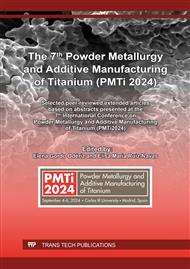p.3
p.13
p.21
p.31
p.41
p.49
p.57
p.65
p.73
Additive Manufacturing of TiBw-Reinforced Titanium Matrix Composites Fabricated by Electron Beam Melting: Microstructure and Mechanical Properties
Abstract:
TiBw reinforced titanium matrix composites (TMCs) are the most promising engineering materials in aerospace and transportation owing to their excellent properties such as lightweight, high strength, wear resistance. The electron beam powder bed fusion (EB-PBF) characterized by its rapid solidification process during the manufacturing, which can effectively controlling the microstructure and mechanical properties of DRTMCs. The state of feedstock used in EB-PBF has a significant influence on the microstructure and mechanical properties of DRTMCs prepared by EB-PBF. However, there is no commercial feedstock available for EB-PBF fabricating DRTMCs. The disadvantages of premixed ball-milled powder are degraded flowability or incomplete reaction and agglomeration of reinforcements, which causes metallurgical defects in the as-fabricated composites. These issues severely affect the stability of mechanical properties of DRTMCs prepared by EB-PBF. The introduction of TiBw led to the formation of melt pool structure. At the boundary of the melt pool, TiBw exhibits an equiaxed continuous network distribution, while at the center of the melt pool, TiBw exhibits a columnar continuous network distribution; Moreover, the introduction of TiBw resulted in a 75% grain refinement, a 40% increase in yield strength, a 54% increase in tensile strength, and a decrease in elongation (13.2%) in the composite material. The improvement in strength of Ti-TiBw composite material prepared by EBM is due to grain refinement and the good load transfer effect generated by high aspect ratio TiBw, while the decrease in plasticity of the composite material is due to the connectivity failure of TiBw on the matrix. Based on the current research of DRTMCs prepared by EB-PBF, the future research trend focus on TiBw reinforced DRTMCs prepared by EB-PBF is discussed.
Info:
Periodical:
Pages:
41-47
Citation:
Online since:
March 2025
Authors:
Price:
Сopyright:
© 2025 Trans Tech Publications Ltd. All Rights Reserved
Share:
Citation:



